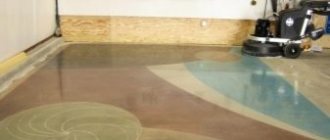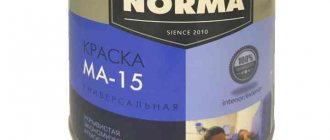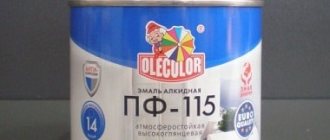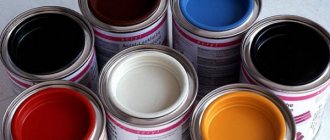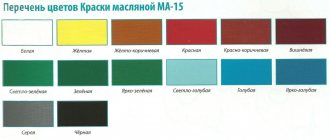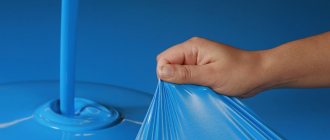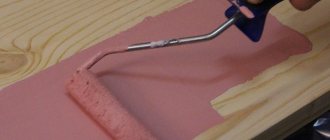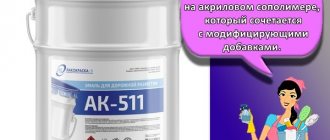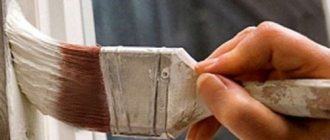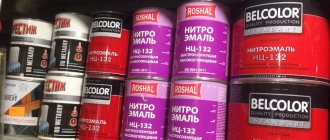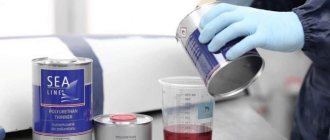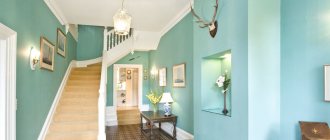Enamel paint PF-115 was developed back in the 1970s, and continues to be popular, despite the abundance of new paints and varnishes. This popularity is due to the operational and technical characteristics of PF-115 enamel: excellent adhesion to diverse surfaces, elasticity, decorative appearance, etc.
In terms of its chemical composition, PF-115 is a suspension of pigments, specialized fillers and modifiers in an alkyd mixture. The paint is based on pentaphthalic varnish. The explanation of the “PF-115” marking is as follows:
- PF - an indication of the pentaphthalic paint base;
- 1 – means that the material is weather-resistant (suitable for outdoor use);
- 15 is the number of this enamel in the paint and varnish catalogue.
The production of PF-115 paint is carried out in accordance with GOST 6465-76. White spirit is predominantly used as a solvent. The enamel of this brand has high hiding power and, after application, forms a uniform, smooth coating without unevenness or cracks.
Technical characteristics of paint PF-115
- Resistance to atmospheric and weather factors (precipitation, ultraviolet radiation, temperature changes, wind loads).
- Resistance to chemical influences: PF-115 paint can withstand the effects of fuels and lubricants for 24 hours, at least 2 hours - water, up to 15 minutes - aggressive detergents.
- Adhesion – about 1 point. There are also oil-based versions of enamel paint on sale that have less adhesion.
- Covering capacity – 80 ± 40 g/m2.
- The percentage of non-volatile components in enamel paint is in the range of 49–70% (depending on the paint manufacturer).
- Specific hardness – 0.15–0.25 conventional units.
- Viscosity – 90 ± 30 conventional units.
- Drying time - up to 24 hours under normal conditions (humidity up to 65% and temperature about 20 ° C). For cherry and red paint, drying time is up to 48 hours.
- Flexural elasticity is about 1 mm.
- Operating temperature range – from -50 to +60 °C.
What is it, varieties and characteristics
Such paints have an excellent degree of adhesion, and therefore the film that forms after drying will protect not only from moisture getting inside, but also from an aggressive chemical environment. When creating paints for polyvinyl chloride, a light-resistant pigment is used, because the bright color of the facade will last up to six years or even more. Perchlorovinyl paints are produced in accordance with GOST 25129-82. When purchasing a product, you should make sure that it will comply with it and is not produced according to specifications. The most popular today are façade paints of the XB-192 and XB-161 brands, which are enriched with special plasticizers that will increase their scope of application and excellent properties.
The paint for facades under the brand XB-161 is almost universal, and it can be worked with over a wide temperature range (from -20 to +45 degrees). It will be a suspension of color pigments, which will be dissolved in PVC varnish with the addition of fillers.
This material is perfect for decorative finishing of part of the facade of brick buildings, as well as houses and plaster coatings. XB-192 is a perchlorovinyl enamel, which is a modified product that contains a plasticizer (PDEA). Due to this, the percentage composition of the fractional content of non-volatile substances is reduced (this can be approximately 35%). The paint is used to decorate facades made of concrete and brick, and it also has a high degree of adhesion.
XB-182 can be applied directly to the surface, without preparation. The film is obtained by evaporating xylene, and this makes it possible to finish facades in winter at subzero temperatures. Although the compositions of perchlorovinyl-type paints and varnishes are slightly different, they will all have common characteristics.
In particular, the paint and varnish material has a normal viscosity level (approximately 40 s), and therefore no solvents need to be added before painting the surface. The painted surface will dry for four hours and one kilogram of paint and varnish composition will be used per four square meters. The average material consumption will be approximately 0.18 to 0.22 kg per square meter, but the paint should be applied in a couple of layers.
Scope of application of PF-115 paint
High adhesion makes PF-115 enamel universal and provides the possibility of its use on various surfaces: metal, wood, brick, plaster, concrete, fiberboard, asbestos cement, plasterboard, chipboard, etc. This material is used:
- for interior work. PF-115 paint is used to paint wooden windows and doors, metal radiators and pipes, wall panels and other indoor surfaces;
- for outdoor work. The scope of application of PF-115 enamel includes painting fences, verandas, benches, outbuildings, and landscape decorative structures.
Please note: PF-115 paint is not abrasion resistant, so its use on floors and other surfaces subject to significant physical stress is not recommended.
Advantages and disadvantages
The positive characteristics of perchlorovinyl paints include:
- high adhesion to a wide variety of surfaces,
- deep penetration into the material, which ensures reliable protection not only of the surface, but also of other parts of the structure,
- coating strength,
- resistance to different temperature conditions,
- color fastness (paint does not fade for a long time).
Perchlorovinyl compounds also have disadvantages:
- the paint should not be applied in hot or rainy weather (ultraviolet radiation and too much water damage the quality of the composition),
- insufficient elasticity, as a result of which increased demands are placed on the surface - it must be perfectly flat, otherwise cracking of the coating cannot be avoided.
Advice! To speed up the drying time of the surface, it is recommended to add a soap solution to the composition.
How to work with PF-115 enamel
Preparing the surface for applying PF-115 paint
Proper preparation helps prevent the formation of unevenness and peeling, and ensure a neat, decorative appearance of the surface. Main stages of work:
- cleaning Remove old paint, dust, grease and other contaminants from the surface. For this, use soda or soap solution, washing powder or other means (depending on the type of dirt). Clean metal surfaces from rust, and treat wooden surfaces with sandpaper. Pentaphthalic compounds can be applied over old paint, but the surface must be thoroughly sanded;
- drying. During the warm season, it is carried out naturally; in the cold season, heat guns can be used. Drying time depends on the material; pay special attention to drying porous surfaces (concrete, plaster);
- padding. The metal is treated with a degreasing compound, then with an anti-corrosion primer. A universal varnish, a specialized primer or drying oil is applied to the wood. Alkyd primers are suitable for porous materials.
Painting with PF-115 enamel
For painting, use the usual painting tools: rollers, brushes, brushes, spray guns. The choice of type and size of tools depends on the dimensions and configuration of the structures or surfaces to be processed. Small parts can be dip painted. The recommended temperature for applying PF-115 enamel is 5–35 °C. Work order:
- paint preparation. Open the jar, dilute the enamel with solvent if necessary, stir with a wooden stick until smooth;
- application. Distribute the paint evenly over the surface to be treated using a roller, brush or other tool of your choice;
- drying. Usually it is carried out under natural conditions. The process can be accelerated by using heat guns or other heating equipment (but the temperature of such processing should not exceed 100–110 ° C).
To ensure maximum quality, PF-115 enamel is applied in several layers. Each subsequent layer is applied after the previous one has dried, and the total amount depends on the nature of the surface:
- metal – at least 2 layers;
- concrete, brick, plaster, wood - 2–3 layers, each 20 ± 3 mm thick.
The color of the paint and its proximity to the shade of the surface being painted also matters.
Marking of paints and varnishes
Home Useful information on paints and varnishes Marking paints and varnishes
There is a generally accepted system in our country for designating paints and varnishes, which reflects their properties, purpose, and operating conditions. When you choose any paint or varnish in a store, it is enough to decipher the designation on the can according to the rules below, and you will know exactly what this paint and varnish material is intended for, where and how it can be used.
Each paint and varnish material is assigned a name and designation consisting of letters and numbers. The designation of varnishes consists of four, pigmented materials - of five groups of signs.
The first group means the type of paint and varnish material and is written with the word - varnish, paint, enamel, primer , putty.
The second group indicates the type of film-forming substance, denoted for brevity by two letters MA, PF, ML, etc. For paints and varnishes produced with mixed film-forming agents, the second group of signs is designated by the film-forming agent, which determines the properties of the material.
Paints and varnishes based on polycondensation resins
AC - Alkyd-urethane UR Polyurethane GF FA - alkyd KO Organosilicon FL - ML - Melamine CG - Cyclohexanone MP - Urea (urea) EP - Epoxy PL - Polyester saturated ET - Ethrifthalic PF - Pentaphthalic EF - Epoxyether nye PE - Polyester unsaturated
Paints and varnishes based on polymerization resins
AK - Polyacrylate VA - Polyvinyl acetate NP - Petroleum polymer VL - Polyvinylacetal FP - Fluoroplastic VS - Based on vinyl acetate copolymers XV - Perchlorovinyl CP - Rubber HS - Based on vinyl chloride copolymers
Paints and varnishes based on natural resins
BT -Bitumen SHL - Alkaline KF -Rosin YAN -Amber MA -Oil
Paints and varnishes based on cellulose ethers
AB - Cellulose acetobutyrate NC - Cellulose nitrate AC - Cellulose acetyl EC - Ethylcellulose
The third group indicates the preferential operating conditions and purpose of the paint and varnish material, indicated by a single number from 1 to 9, as indicated in the table below.
- 00 — Putties
- 0 — Primers
- 1 - Weatherproof
- 2 - Limited weather resistance
- 3 - Protective, conservation
- 4 - Waterproof
- 5 - Special
- 6 — Oil and petrol resistant
- 7 - Chemical resistant
- 8 - Heat resistant
- 9 — Electrical insulating
A hyphen is placed between the second and third groups of characters ( enamel ML-12, varnish PF-2).
The fourth group is simply a serial number assigned to the paint and varnish material during its development, denoted by one, two or three digits ( enamel , varnish ).
The fifth group (for pigmented materials) indicates the color of the paint and varnish material - enamel, paint, primer, putty - in full ( enamel ).
Exceptions to the general rules:
When designating the first group of marks for oil paints containing only one pigment, instead of the word “ paint ” the name of the pigment is indicated, for example “red lead”, “mummy”, “ocher”, etc. (red lead MA-15).
For a number of materials, indices are placed between the first and second groups of signs:
B - without volatile solvent C - for water-borne VD - for water-dispersed OD - for organo-dispersed P - for powder
The third group of signs for primers and semi-finished varnishes is designated by one zero (primer GF-02 for putties - by two zeros (putty PF-002). After the hyphen, before the third group of signs for oil-based thick-rubbed paints, one zero is placed (red lead MA-015).
In the fourth group of signs for oil paints, instead of a serial number, a number is placed indicating which drying oil the paint was made from:
- 1 - natural drying oil
- 2 - drying oil "Oxol"
- 3 — glyphthalic drying oil
- 4 — pentaphthalic drying oil
- 5 - combined drying oil
In some cases, to clarify the specific properties of the paint and varnish coating, after the serial number a letter index is placed in the form of one or two capital letters, for example: B - high-viscosity; M matte; N - with filler; PM - semi-matte; PG-reduced flammability, etc.
All necessary information is provided on the paint or varnish , which contains the full name of the material indicating GOST or TU, its purpose, method of application, precautions, manufacturer, production date and batch number.
State standard (GOST) and technical conditions (TU) are regulatory documents that stipulate the properties of the material, testing methods for individual indicators, precautions and conditions for handling the material, rules for transportation and storage, warranty obligations. These are voluminous documents and, naturally, they are not attached to every package arriving at the store. To familiarize yourself with the content of regulatory documents (GOST, OST, TU), they can be found in technical libraries.
Safety precautions when working with PF-115 paint
- Use personal respiratory and eye protection (respirator and goggles, respectively).
- Protect your hands: use gloves; if paint gets on your skin, immediately wash the area with warm water and soap.
- Take care of ventilation. It can be natural or artificial. If work is carried out indoors, the room must be ventilated upon completion of painting.
- Ensure fire safety: there should be no open sources of flame near the structure to be painted.
- Observe storage conditions. Since enamel is flammable, keep it away from sources of fire. Provide protection from direct sunlight and high humidity.
Advantages and disadvantages
The advantage of vinyl chloride paints is a high degree of adhesion to the material of the surface being treated.
Thanks to this, the coloring layer is able, without changing the color shade, to protect the painted product from exposure for a long time:
- moisture;
- wind;
- ultraviolet radiation;
- low and high temperatures;
- aggressive environments.
The disadvantage of PVC-based paints is the mandatory careful preparation of the surface due to low fluidity:
- dust removal;
- degreasing;
- padding;
- surface leveling.
During painting work, optimal conditions for temperature and air humidity must be observed (work cannot be carried out in rainy, hot/cold weather).
Popular manufacturers of PF-115 paint
Many Russian brands are engaged in the production of PF-115 paint. The following brands are the most popular:
- Lakra.
- Tex.
- Leningrad paints.
- Optimum.
- Colorist.
- Super color.
There are two types of PF-115 on sale: for household and industrial purposes. The differences lie in the release form. Industrial formulations are concentrated and require the addition of solvents. Paints and varnishes for household use are produced ready for application. The need for dilution arises if the paint has thickened. When purchasing, pay attention to the presence of a certificate of conformity.
In what shades is PF-115 paint available?
According to GOST 6465-76, PF-115 enamel is available in more than 20 different colors. Depending on this, the type of coloring pigments that are added to the composition varies. For example, white enamel contains zinc white, blue enamel contains iron glaze, and gray enamel contains carbon black. There are also paintwork materials on sale in red, black, brown, yellow, green and other colors. Other shades can be obtained by mixing or coloring. Also pay attention to the gloss level: the resulting finish can be matte, glossy or semi-matte.
Compliance with government standards
The production technology of PF-115 enamel is standardized by GOST 6465-76. This standard was developed by the USSR Ministry of Chemical Industry in 1976. Also, in order to regulate key aspects of the production process, other state standards were created and are still used in practice. A direct list of GOSTs containing information about the qualities of enamel is as follows:
- 9980.1 - contains the basic rules for acceptance;
- 9980.2 - procedure for taking enamel samples
- 9980.3 - regulates standards for the use of packaging and labeling
- 12.1.005 - lists the hazard classes of components present in the paint
- 12.1.044 - contains all the information about the fire hazard of the material
- 12.3.005b 12.1.004 - contains the necessary requirements for the production process, as well as the use of the material.
The state standard also determines what protective equipment and clothing should be used to ensure maximum compliance with safety requirements.
The main advantages of PF-115 enamel
- Moisture resistance. The coating withstands direct contact with water, precipitation, and protects the painted surface from corrosion.
- Economical. The consumption of enamel paint is 140 ± 40 g/m2 and depends on the method of application, type of surface, etc.
- Resistant to fading. PF-115 paint is resistant to ultraviolet rays, so the coating does not fade or fade.
- Resistance to chemical influences. This means that painted surfaces can be cleaned using detergents.
- Versatility. PF-115 is suitable for various surfaces, perfectly combined with decorative plaster, varnished wood, etc.
- Affordability. With its high technical characteristics, enamel paint PF-115 is inexpensive compared to many other paintwork materials.
Features of HB paint
The dye is based on a solution of PVC polymer in xylene or solvent. Vinyl chloride paints, after drying, create a durable decorative coating that is resistant to temperature changes and high humidity. The purpose of coloring agents is finishing metal, wood and concrete surfaces.
Manufacturers mark XB paints with a standard category index (GOST) or TU (technical conditions). In the first case, the number of the standard and the year of adoption (with a hyphen), established under the USSR, are indicated. Specifications can be developed by the manufacturer. The document contains information about the technical requirements for product quality and the necessary production conditions for this.
Disadvantages of PF-115 enamel
- Fire hazard. This paint is flammable, so it must be protected from open flame sources.
- Characteristic smell. For this reason, and also because of some toxicity, it is necessary to ensure good ventilation when working with PF-115, use a respirator and other personal protective equipment.
- Drying time. The process lasts about a day, and at temperatures below 20 ° C it takes even longer, which not all users like.
- Difficulty in laundering. After drying, enamel paint PF-115 is difficult to remove, including from painting tools and work clothes.
What to look for when choosing?
Since the cost of these materials is affordable, low-quality compositions may be offered on the market. Quality characteristics are described in detail in GOST 6456-76. A quality product is offered at a price of at least 65 rubles per 1 kg. If the cost is 40 rubles or less, then you don’t have to read the description on the can - it’s a fake product.
It is easy to recognize a fake or low-quality enamels. There are several signs:
- Very strong solvent smell. White spirit is found in all types of enamel paints, but if the smell is too strong, the composition is of low quality.
- The film does not appear even after storing the open jar outdoors for a long time.
- The coating does not dry out for a long time even at high temperatures.
